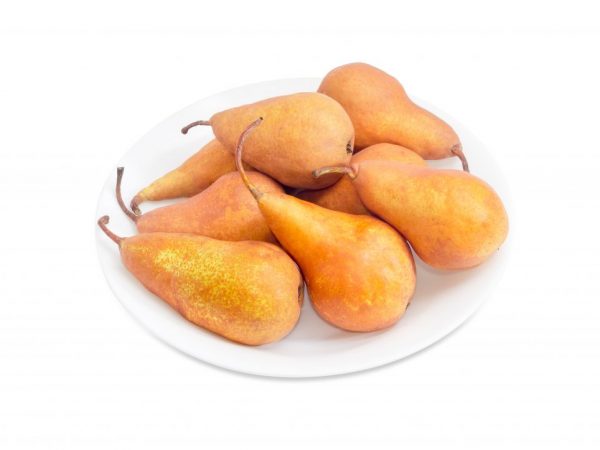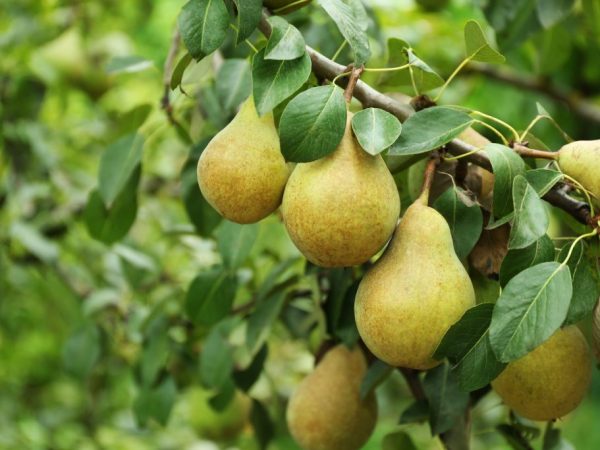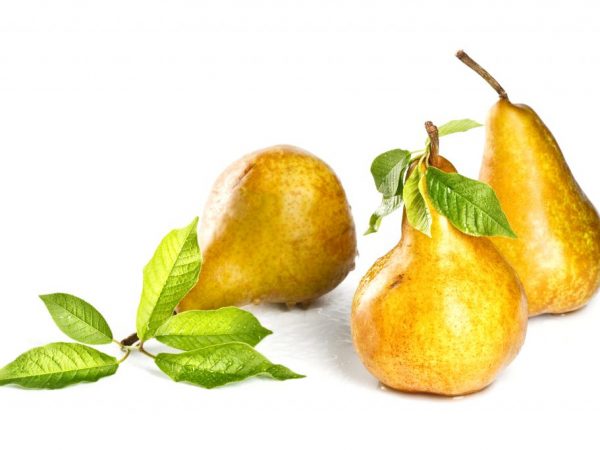Characteristics of Bere pears
Pear Bere is one of the most famous varieties. It has many types, each of which is popular throughout Europe.

Characteristics of Bere pears
Characteristics of the variety
All varieties have different characteristics. Each individual species differs in terms of fruit ripening, appearance and parameters. The varieties of the family ripen at different times, but most of them in the fall.
Description of trees
Pear variety, according to the description, is of medium height, but with a large crown. Over the years, the foliage becomes dense, and the crown becomes wide.
The shoots and trunk are thick, the leaves are oval, with rounded ends. The flowering period falls on the late period, so the inflorescences are not affected by recurrent frosts.
Description of fruits
According to the description, the fruits of the Bere family reach 200-300 g.
Their skin is yellow, yellow-green, golden, greenish or red. The fruits ripen from late July to early November. The average shelf life of fruits is up to a month.
Summer varieties
These are special varieties that bear fruit from mid-July to late August, and even in autumn in some northern regions of Europe. The fruits are tender and sensitive to storage conditions, therefore they are stored for no more than 3 weeks.
Gold grade
The golden pear was obtained by breeders in Belarus. After planting, at least 5 years must pass before the tree begins to bear fruit. It usually bears fruit at the end of August, the fruit remains in good condition for about a week.
The trunks reach a height of 3 m and have good resistance to bacterial cancer and scab. The bush is resistant to winter time and resistant to low temperatures.
Bere Giffard
The Giffard variety has a low tree and does not require special conditions for growth.
As the tree matures, growth slows down, but its resistance to cold increases and yields increase. Fruits are not prone to scab disease, but are sometimes able to pick up fruit rot.
Bere Summer
Pear Bera, or Summer, is fast-growing and early: it bears fruit from 4 or 5 years of growth, is resistant to low temperatures.
Its yield after 15 years reaches 120 kg of dessert fruits. The bush bears fruit in early August, the fruits are scab resistant.
Autumn varieties

Autumn varieties are resistant to frost
The autumn varieties are characterized by a low yield stability. The fruits are soft and sweet, therefore they cannot withstand high temperatures and adverse weather conditions. Harvested from September to early October.
The fruits, taken in advance, ripen at home and improve the taste characteristics. Under the right conditions, such fruits can be stored for up to 70 days. Most varieties are frost-resistant.
Bere Russkaya
Pear Bere Russkaya is distinguished by its resistance to low temperatures and good yield.
The fruits are tasty and have a long shelf life.Russian pear is resistant to various diseases and has no significant drawbacks.
Bere Clergeau
Clergeau is a subspecies that bears fruit for 4-5 years after planting and tolerates low temperatures well.
The fruits ripen quickly and fall off. The fruits are very sweet, can be stored for up to a month, are resistant to scab, but sometimes they are affected by the moth.
Moscow
Moscow pear is the result of selection of several summer and autumn varieties. This is a fast-growing variety, the seedlings bear fruit already 3 years after planting.
The bush bears fruit on short branches. The fruits themselves are soft and juicy, if not removed in time, they quickly overripe. Resistant to disease and cold.
Krasnokutskaya
Krasnokutsk pear bears fruit already for 4 years, is winter-hardy and resistant to scab.
The pear has a high yield: for the 15th year of life, it bears up to 130 kg of fruits. The fruit is harvested from the end of September.
Bere Bosc

The variety has a high yield.
Pear of the Bere Bosk variety is one of the most popular autumn varieties of the family. Bosk is capable of reaching large sizes and has a good yield. Fruiting begins 6-7 years after planting.
Fruits ripen from September. The fruits of the Bosk tree are large, stored for up to a month. Usually, ripe fruits adhere firmly to the branches and do not crumble even after ripening.
Luke
Bere Luca pear is a late autumn variety bred in France. It has high resistance to scab and septoria and bears fruit regularly.
The variety has small fruits with a greenish tint, yellow or green skin, which is distinguished by good density. The first fruits are harvested in November.
Winter varieties
Winter varieties ripen by mid-autumn. They are grown in regions with a mild climate, where there is still no frost in November.
Overripe fruit should not be allowed, otherwise the fruit will fall off, damage the shell and lose its unique soft taste. Late winter pear can be stored for up to 5 months at a temperature of 3-5 ° C.
Bere Kievskaya
The Kiev variety is fast-growing and bears fruit already 4 years after planting. Young trees may not give large yields, but later the owners will have high fertility.
The pear is not afraid of low temperatures and lack of moisture, it is resistant to diseases. In good conditions, the fruit can be stored for up to 3 months.
Bere Zimnyaya Michurina
Pear Bere Winter named after Michurin is the result of crossing the Ussuriiskaya Dikaya and Royal varieties. It is resistant to cold weather, prone to scab.
The variety bears fruit regularly and stably from 6-7 years after planting. The fruit is sweet and versatile to use.
Bere Ardanpon
The pear variety Ardanpon Bere was bred in Belgium in the 18th century. The seedling got its name from the name of the discoverer of the unknown pear. This is the latest variety and is very picky about growing conditions.
Ardanpon Bere is not resistant to low temperatures, but it gives a good harvest, the fruits are stored for a long time. The yield depends on the region of cultivation, and the fruits themselves are stored for up to 4 months.
Growing rules
Bere varieties are undemanding to growing conditions. They grow well on light to loose soils with medium moisture.
If the tree grows in the shade or in wetlands, the yield will not be high, but there are some guidelines for growing:
- when planting a young tree, you need to provide it with all the conditions for growth, as well as cut off the upper branches with leaves;
- in the early stages of growth, organic and nitrogen-containing fertilizers must be used to improve the growth of the tree;
- all trees require fertilizers with the presence of potassium, so you need to constantly monitor the composition of the soil;
- be sure to water each plant 3-4 times a day in dry and hot weather in the amount of 3 buckets of water;
- in mid-autumn, the soil should be digged to a depth of no more than 15 cm.
Otherwise, it is an undemanding variety that is resistant to low temperatures. Bere is resistant to disease, but not immune to pests.The most common infections are scab, cytosporosis and rust.
Conclusion
There are many popular varieties of the Bere family: Bere Ligel, Bere Loshitskaya, Bere Dricha, Bere Shuiskaya, Bere Slutskaya or Bere Morettini and others. All varieties have excellent yields and good tasting fruits.
Caring for Bere is standard - even a novice summer resident is able to achieve success in growing these beautiful pears.


